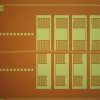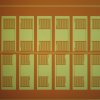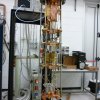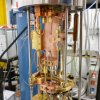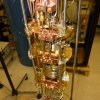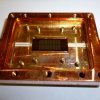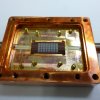Microresonators for neutrino physics
We are running a project to develop new particle detectors based on the superconducting microwave microresonator technique. These low temperature detectors are very sensitive devices compatible with large-scale multiplexed frequency domain read-out. They are sensitive to the energy absorbed through a characteristic property of superconductors subjected to an electromagnetic field: the kinetic inductance, which is related to the kinetic energy stored by the Cooper pairs in their motion within the superconductor. The faint binding energy of the Cooper pairs (order of the meVs) make the theoretical energy resolution extremely good.
So far microwave microresonator were developed mostly for bolometric measurements in millimiter astronomy or in cosmic microwave mapping. Our project aims to adapt and further advance the technology of microresonator detectors to develop new devices for single particle detection and high resolution spectroscopy.
This devices can find application in many fields. Our first aim is to develop detectors for neutrino physics.
In particular we plan to realize detector arrays for calorimetric measurement of the energy spectra of 163Ho EC decay for a direct measurement of the neutrino mass.
We are also exploring the possibility of designing new devices for high energy resolution broad band (1-100 keV) photon spectroscopy. Kilo-pixel arrays of such devices may have a large impact in many frontier fields like astrophysics, material analysis, nuclear safety and diagnostic, archeometry, ...
In order to achieve these goals, we are optimizing the design and developing new materials for the detectors in collaboration with the Micro-ElectroMechanical Systems at Fondazione Bruno Kessler (Povo, Trento, Italy). A recent advance in microwave microresonator technology was the discovery that some metal nitrides, such as TiN, possess properties consistent with very high detector sensitivity. We have developed a technique for producing sub-stoichiometric TiN device which allows a precise and reliable control of the transition temperature. We plan to investigate also nitrides of higher-Z materials, for example TaN and HfN, that are appropriate for achieving a high quantum efficiency in broad band photon spectroscopy.
- M. Faverzani et al., "Developments of Microresonators Detectors for Neutrino Physics in Milano", Journal of Low Temperature Physics, vol. 167, issue 5-6, pp. 1041-1047, June 2012, DOI
- A. Nucciotti, "Developement of superconducting microwave microresonators for broad band high energy resolution particle detection", slides presented at the Italian National Conference on Condensed Matter Physics (FisMat 2013), Milan (Italy), 09-13 September 2013
- A. Giachero et al., "Critical Temperature tuning of Ti/TiN multilayer films suitable for low temperature detectors", accepted for publication on Journal of Low Temperature Physics, Journal of Low Temperature Physics 176(3-4):155–160, August 2014. DOI BibTeX
- M Faverzani et al., "Development of Superconducting Microresonators for a Neutrino Mass Experiment", Journal of Low Temperature Physics 176(3-4):530–537, August 2014. DOI BibTeX
- M Faverzani et al., "Superconducting Detectors for Neutrino Mass Measurement", IEEE Transactions on Applied Superconductivity 26(3), April 2016. DOI BibTeX
- M Faverzani et al., "Thermal kinetic inductance detectors for soft X-ray spectroscopy", NIM-A 936:197-198, 2019. DOI BibTeX
- M Faverzani et al., "Electron-Phonon Coupling in Ti/TiN MKIDs Multilayer Microresonator", Journal of Low Temperature Physics 193(3-4, 1, SI):189-195, November 2018. 17th International Workshop on Low Temperature Detectors (LTD), Kurume, JAPAN, JUL 17-21, 2017. DOI BibTeX
- A Giachero et al., "Development of Thermal Kinetic Inductance Detectors Suitable for X-ray Spectroscopy", Journal of Low Temperature Physics 193(3-4, 1, SI):163-169, November 2018. 17th International Workshop on Low Temperature Detectors (LTD), Kurume, JAPAN, JUL 17-21, 2017. DOI BibTeX
- M. Faverzani et al., "Characterization of the low temperature behavior of thin Titanium/Titanium Nitride multilayer films", Superconductor Science and Technology 33(4):045009, February 2020. URL, DOI BibTeX
- Mezzena et al, "Development of Microwave Kinetic Inductance Detectors for IR Single-Photon Counting", Journal of Low Temperature Physics 199: 73-79, DOI

This activity has been supported by Fondazione Cariplo (International Recruitment Call 2010, Grant n. 2010-2351)
